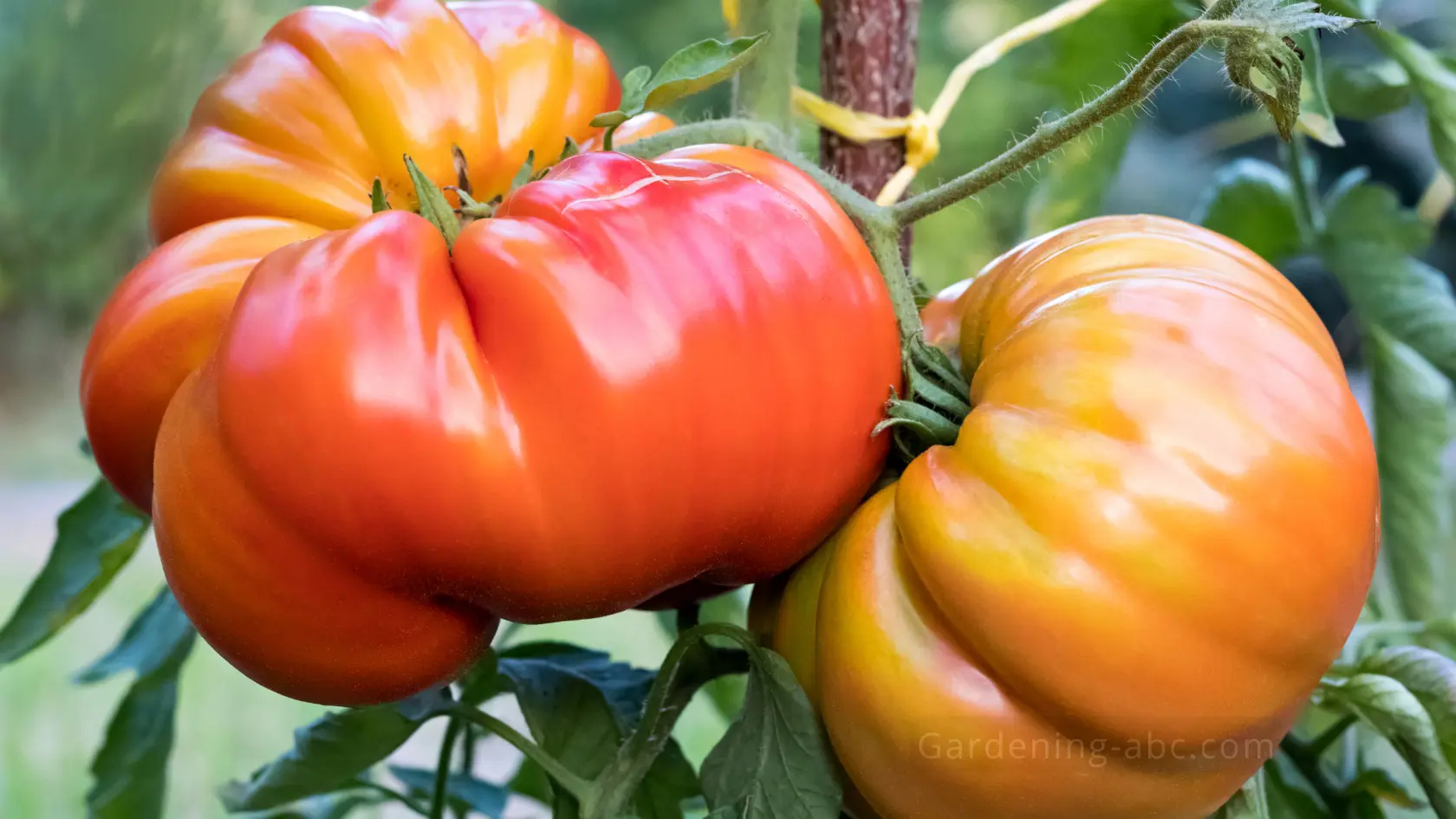We use affiliate links to run our site. When you buy through links on our site, we may earn an affiliate commission, without any added cost to you. Learn more
Close your eyes and imagine it: the unparalleled taste of a tomato plucked fresh from the vine, still warm from the sun. It’s sweet, complex, and bursts with a flavor so intense it bears almost no resemblance to its plastic-wrapped cousins at the grocery store.
If you’ve ever strolled through a farmers market and marveled at the lumpy, striped, and vibrantly colored tomatoes with the shocking price tag, you’ve met an heirloom. But here’s the secret: you don’t have to pay $6 a pound to enjoy them. You can grow these gems right in your own backyard.
This guide will demystify the world of heirloom tomatoes, giving you the confidence and practical tips you need to cultivate your own crop of these flavorful, story-filled fruits.

What Makes an Heirloom Tomato So Special?
Before we dig in, let’s clear up what “heirloom” actually means. Unlike the modern hybrid tomatoes bred for uniform size and cross-country shipping, heirlooms are all about history and flavor.
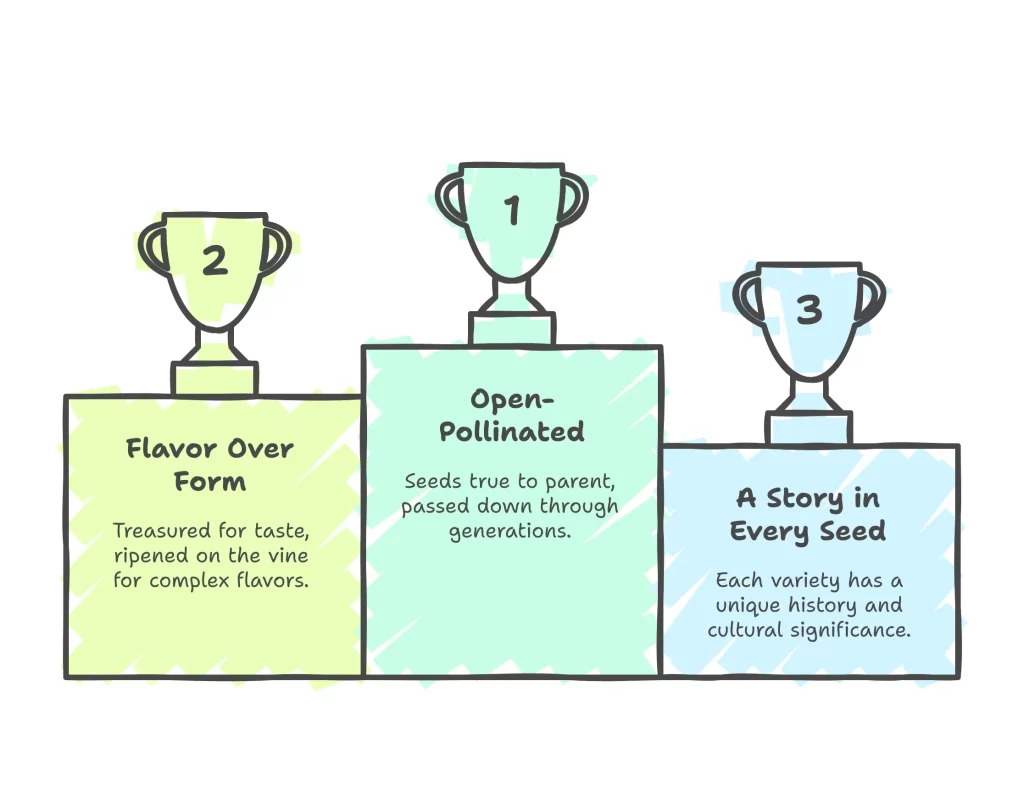
- Open-Pollinated: This is the key. It means if you save the seeds from an heirloom tomato, the plant you grow next year will be true to its parent. These seeds have been passed down through families and communities for generations, often for 50 years or more.
- Flavor Over Form: Heirlooms were treasured for their taste, not their ability to survive a bumpy truck ride. While supermarket tomatoes are often picked green and gassed with ethylene to turn them red (destroying flavor in the process), heirlooms ripen on the vine, developing a complex balance of sugars and acids.
- A Story in Every Seed: Each heirloom variety has a history. The ‘Mortgage Lifter’ tomato really did help a man pay off his mortgage. The ‘Cherokee Purple’ is said to have been passed down from the Cherokee people. When you grow an heirloom, you’re not just gardening; you’re becoming part of a story.
A Rainbow of Flavors: Decoding Tomato Colors
Think all tomatoes taste the same? Think again! The color of an heirloom is often a fantastic clue to its flavor profile.
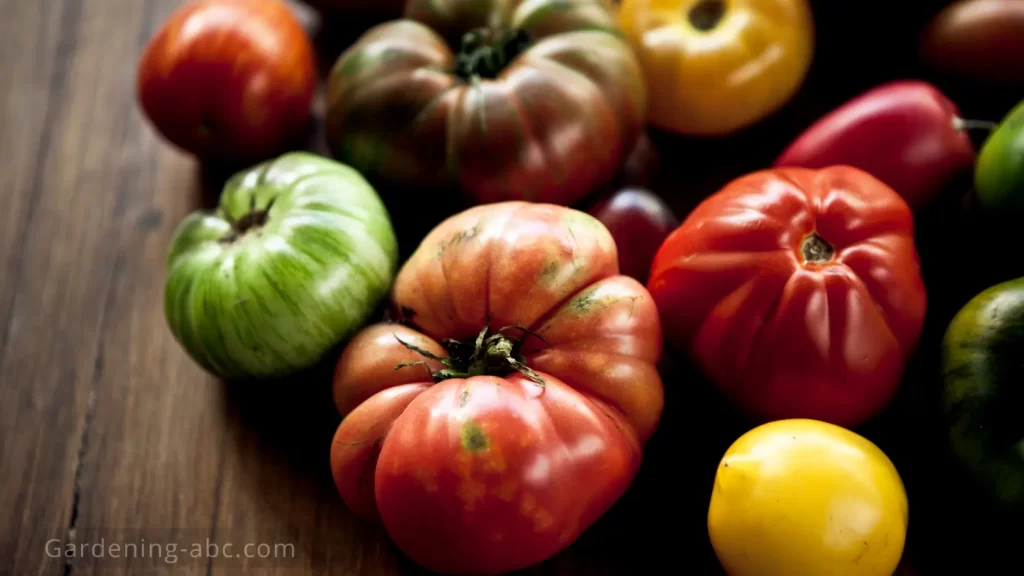
- ⚫ Purple & Black (e.g., Cherokee Purple, Black Krim): These are the rockstars of the tomato world. Expect a rich, complex, and savory flavor, often described as “smoky” or “earthy.” They have a fantastic depth that’s unforgettable.
- 🔴 Red & Pink (e.g., Brandywine, Mortgage Lifter): These offer that classic, balanced tomato taste—a perfect harmony of sweet and tangy. They are the quintessential flavor that many of us crave for a perfect tomato sandwich.
- 🟠 Orange & Yellow (e.g., Persimmon, Lemon Boy): Tend to be milder, sweeter, and less acidic, with a distinctly fruity character. They are a great “gateway tomato” for people who find other tomatoes too acidic.
- 🟢 Green (when ripe!) (e.g., Green Zebra, Aunt Ruby’s German Green): Don’t be fooled by their color! Ripe green tomatoes are a flavor explosion. They often have a bright, zesty, and tangy taste, almost like they have a hint of citrus.
- ⚪ White (e.g., White Tomesol): The most subtle of the bunch. These pale tomatoes are delicate, low in acid, and subtly fruity. They are best enjoyed fresh in a salad where their unique flavor won’t be overwhelmed.
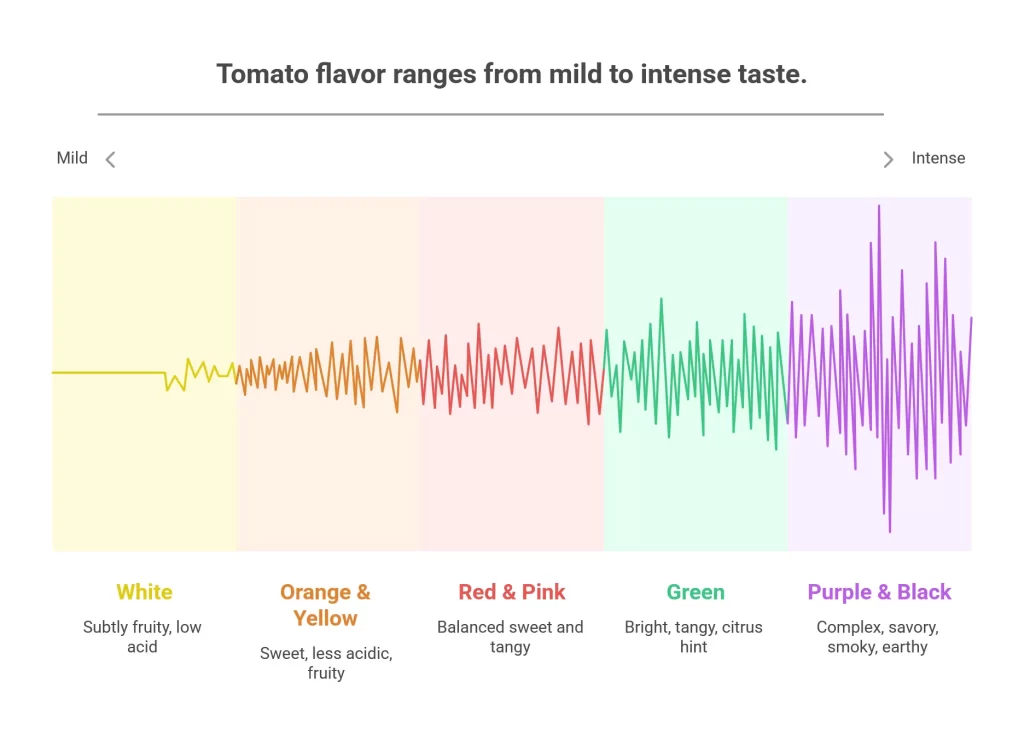
Five Must-Try Heirlooms to Get You Started
With over 3,000 heirloom varieties available, choosing one can be overwhelming. Here are five beloved, time-tested varieties that consistently deliver amazing results.
- Cherokee Purple: Often called the best-tasting tomato in the world. Its dusky, purple-black skin gives way to a rich, sweet, and smoky flavor. It’s surprisingly reliable for an heirloom and a perfect slicer for sandwiches and salads.
- Brandywine: The gold standard of beefsteak tomatoes. These large, heavy fruits have an intensely rich, sweet-yet-tangy flavor. Pro Tip: Look for its “potato leaf” foliage—the leaves are smooth-edged, not jagged like most tomato plants.
- Black Cherry: For the snackers! These small, round cherry tomatoes have a deep mahogany color and a flavor that mimics their larger black tomato cousins: incredibly sweet, rich, and complex. They are highly productive and grow well in containers.
- San Marzano: If you dream of making your own rich, flavorful pasta sauce, this is your tomato. This Italian paste variety is meaty, has few seeds, and a low water content, meaning it cooks down into a perfectly balanced, world-class sauce.
- Mortgage Lifter: Known for its fantastic story and gigantic fruit! These massive pinkish-red tomatoes can easily weigh one to two pounds each. They are meaty with a wonderful sweet flavor and are surprisingly productive.
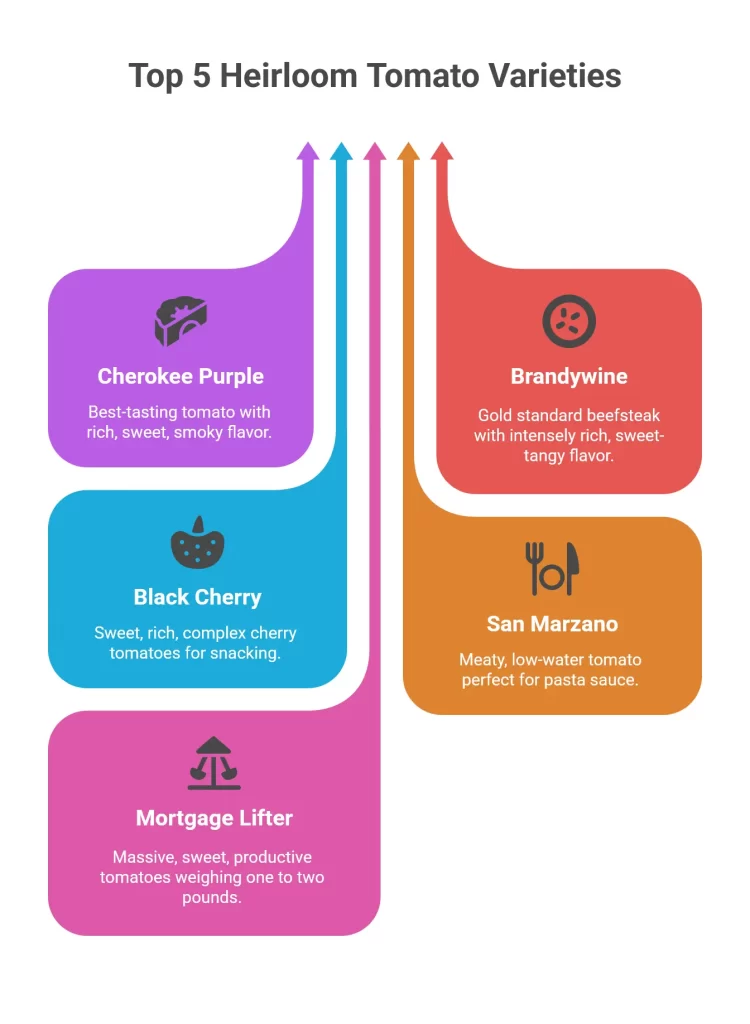
Honorable Mention: While technically a hybrid, SunGold cherry tomatoes are so spectacularly delicious—with a tangy, tropical fruit sweetness—that even the most die-hard heirloom purists often make an exception for them.
Essential Care Tips for a Bountiful Harvest
Heirlooms can have a reputation for being fussy, but success often comes down to a few key practices.
1. Know Your Growth Habit: Determinate vs. Indeterminate
This is the single most important thing to know for planning your garden space and care routine.
- Determinate (Bush Type): These plants grow to a predetermined, compact size (usually 3-5 feet). They produce their fruit all at once over a 4-6 week period.
- Best For: Containers, small gardens, and anyone who wants a large harvest at one time for canning or sauce-making.
- Indeterminate (Vining Type): These plants just keep growing and producing fruit all season long, right up until the first frost. They can easily reach 6-10 feet or more!
- Best For: A steady supply of fresh tomatoes all summer long. They require more space and very sturdy support.
2. To Prune or Not to Prune?
This common question has a simple answer based on the growth type.
- For Determinate (Bush) Plants: DON’T PRUNE. The little “suckers” (shoots that grow in the V between the main stem and a branch) will eventually produce fruit. Pruning them will reduce your overall harvest. Just let them be!
- For Indeterminate (Vining) Plants: DO PRUNE. These vigorous growers can become a tangled mess. Pruning off the suckers focuses the plant’s energy into producing fewer, but larger and higher-quality, fruits. It also dramatically improves air circulation, which is key to preventing disease.
3. Healthy Habits for Healthy Plants
Disease can be the biggest challenge for heirlooms. These organic practices are your best defense.
- Give Them Space: Good air circulation is crucial. Don’t crowd your plants. Spacing them properly allows leaves to dry quickly, making it harder for fungal diseases to take hold.
- Water the Soil, Not the Leaves: Wet foliage is an open invitation for disease. Use a soaker hose or drip irrigation to deliver water directly to the roots.
- Mulch, Mulch, Mulch: A 2-3 inch layer of organic mulch (like straw or shredded leaves) prevents soil from splashing up onto the lower leaves, a primary way diseases spread. It also retains moisture and suppresses weeds.
- Provide Sturdy Support: Use tall, strong cages or a trellis to keep your plants off the ground. This improves air circulation and keeps the fruit clean.
- Feed Wisely: Amend your soil with compost at planting time. The key is to avoid too much nitrogen, especially after flowers appear. High nitrogen gives you a beautiful, leafy green plant, but very few tomatoes.
- Burpee Organic All Purpose Granular Plant Food is…
- The easy-to-apply granules release essential…
- Contains nutrients, plants will produce superior…
The Ultimate Reward: Saving Your Own Seeds
One of the most rewarding parts of growing heirlooms is participating in their history. Because they are open-pollinated, you can save the seeds from your best-tasting, healthiest tomato and grow them next year. You are not only saving money but also helping to preserve genetic diversity and adapting a variety to your specific garden.
Simple Steps To Save Tomato Seeds
Growing heirloom tomatoes is a journey filled with delicious discoveries. It’s a chance to connect with history, fill your plate with a rainbow of flavors, and experience the deep satisfaction that comes from cultivating something truly special.
So, what unique heirloom will you try next season? Your next favorite story is waiting to be tasted.
Amazon and the Amazon logo are trademarks of Amazon.com, Inc, or its affiliates.

Hi there! My name is Prasenjit and I’m an avid gardener and someone who has grown a passion for growing plants. From my hands-on experience, I have learned what works and what doesn’t. Here I share everything I have learned.
